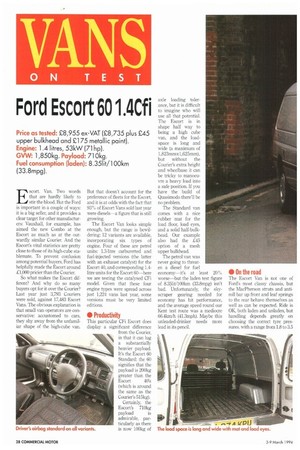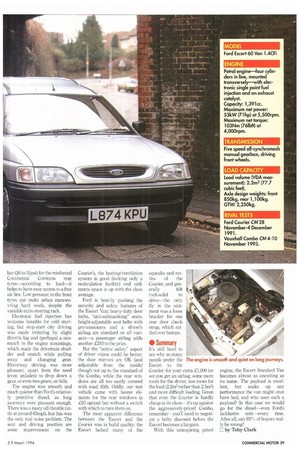Ford Escort 601.4Cfi
Page 30

Page 31

If you've noticed an error in this article please click here to report it so we can fix it.
Price as tested: 28,955 ex-VAT (28,735 plus £45 upper bulkhead and 2175 metallic paint). Engine: 1.4 litres, 53kW (71hp). GVW: 1,850kg. Payload: 710kg.
Fuel consumption (laden): 8.351it/100km (33.8mpg).
F, ;oft. Van. Two words that are hardly likely to Astir the blood. But the Ford is important in a couple of ways: it is a big seller, and it provides a clear target for other manufacturers: Vauxhall, for example, has aimed the new Combo at the Escort as much as at the outwardly similar Courier. And the Escort's vital statistics are pretty close to those of its high-cube stabtemate. To prevent confusion among potential buyers, Ford has helpfully made the Escort around £1,000 pricier than the Courier. So what makes the Escort different? And why do so many buyers opt for it over the Courier? Last year just 3,793 Couriers were sold, against 17,483 Escort Vans. The obvious explanation is that small van operators are conservative: accustomed to cars, they shy away from the unfamiliar shape of the high-cube van. But that doesn't account for the preference of fleets for the Escort, and it is at odds with the fact that 93% of Escort Vans sold last year were diesels—a figure that is still growing. The Escort Van looks simple enough, but the range is bewildering: 12 variants are available, incorporating six types of engine. Four of these are petrol units: 1.3-litre carburetted and fuel-injected versions (the latter with an exhaust catalyst for the Escort 40, and corresponding 1.4litre units for the Escort 60—here we are testing the catalysed CFi model. Given that these four engine types were spread across just 1,224 vans last year, some versions must be very limited editions.
• Productivity
This particular CFi Escort does display a significant difference from the Courier, in that it can lug a substantially heavier payload. It's the Escort 60 Standard: the 60 signifies that the payload is 200kg greater than the Escort 40's (which is around the same as the Courier's 515kg). Certainly, the Escort's 710kg payload is admirable, particularly as there is now 100kg of axle loading tolerance, but it is difficult to imagine who will use all that potential. The Escort is in shape half way to being a high cube van, and the loadspace is long and wide (a maximum of 1,823mmx1,625mm), but without the Courier's extra height and wheelbase it can be tricky to manoeuvre a heavy load into a safe position. If you have the build of Quasimodo there'll be no problem. The Standard van comes with a nice rubber mat for the load floor, load eyes, and a solid half-bulkhead. Our example also had the .C45 option of a mesh upper bulkhead. The petrol van was never going to threaten a diesel for fuel economy—it's at least 20% worse—but the laden test figure of 8.35lit/100km (33.8mpg) isn't bad. Unfortunately, the skyscraper gearing needed for economy has hit performance, and the average speed round our Kent test route was a mediocre 66.4Iun/h (41.3mph). Maybe this unleaded-drinker needs more lead in its pencil. • On the road The Escort Van is not one of Ford's most classy chassis, but the MacPherson struts and antiroll bar up front and leaf springs to the rear behave themselves as well as can be expected. Ride is OK, both laden and unladen, but handling depends greatly on choosing the correct tyre pressures. with a range from 1.8 to 3.5 bar (26 to 51psi) for the reinforced Continental Contrails rear tyres—according to load—it helps to have easy access to a free air line. Low pressure in the front tyres can make urban manoeuvring hard work, despite the variable-ratio steering rack.
Electronic fuel injection has welcome benefits for cold starting, but stop-start city driving was made irritating by slight throttle lag and (perhaps) a mismatch in the engine mountings, which made the drivetrain shudder and snatch while pulling away and changing gear. Motorway driving was more pleasant, apart from the need (even unladen) to drop down a gear, or even two gears, on hills.
The engine was smooth and much quieter than Ford's relatively primitive diesel, so long journeys were pleasant enough. There was a nasty off-throttle rattle at around 63mph, but this was the only real noise problem. The seat and driving position are sonic improvement on the Courier's, the heating,/ventilation system is good (lacking only a recirculation facility) and oddments space is up with the class average.
Ford is heavily pushing the security and safety features of the Escort Van: heavy-duty door locks, "anti-submarining" seats, height-adjustable seat belts with pre-tensioners and a driver's airbag are standard on all variants—a passenger airbag adds another £210 to the price.
Rut the "active safety" aspect of driver vision could be better: the door mirrors are OK (and adjustable from the inside) though not up to the standard of the Combo, while the rear windows are all too easily covered with road filth. Oddly, our test vehicle came with heater elements for the rear windows (a £95 option) but without a switch with which to turn them on.
The most apparent difference between the Escort and the Courier was in build quality: the Escort lacked tnaiw of the squeaks and rat tles of the Courier, and gen erally felt rock-solid to drive—the only fly in the ointment was a loose bracket for one rear door check strap, which rattled over bumps.
• Summary It's still hard to see why so many people prefer the Escort to the Courier: for your extra £1,000 (or so) you get an airbag, some more room for the driver, less room for the load (2.2m3 rather than 2.5m) and more difficult loading. Given that even the Courier is hardly cheap in its class—it's up against the aggressively-priced Combo, remember you'll need to negotiate a hefty discount before the Escort becomes a bargain.
With this uninspiring petrol engine, the Escort Standard Van becomes almost as unexiting as its name. The payload is excellent, but soaks up any performance the van might once have had; and who uses such a payload? In this case we would go for the diesel—even Ford's lacklustre unit—every time. After all, can 93% of buyers really be wrong?
C. by Toby Clark
















































































